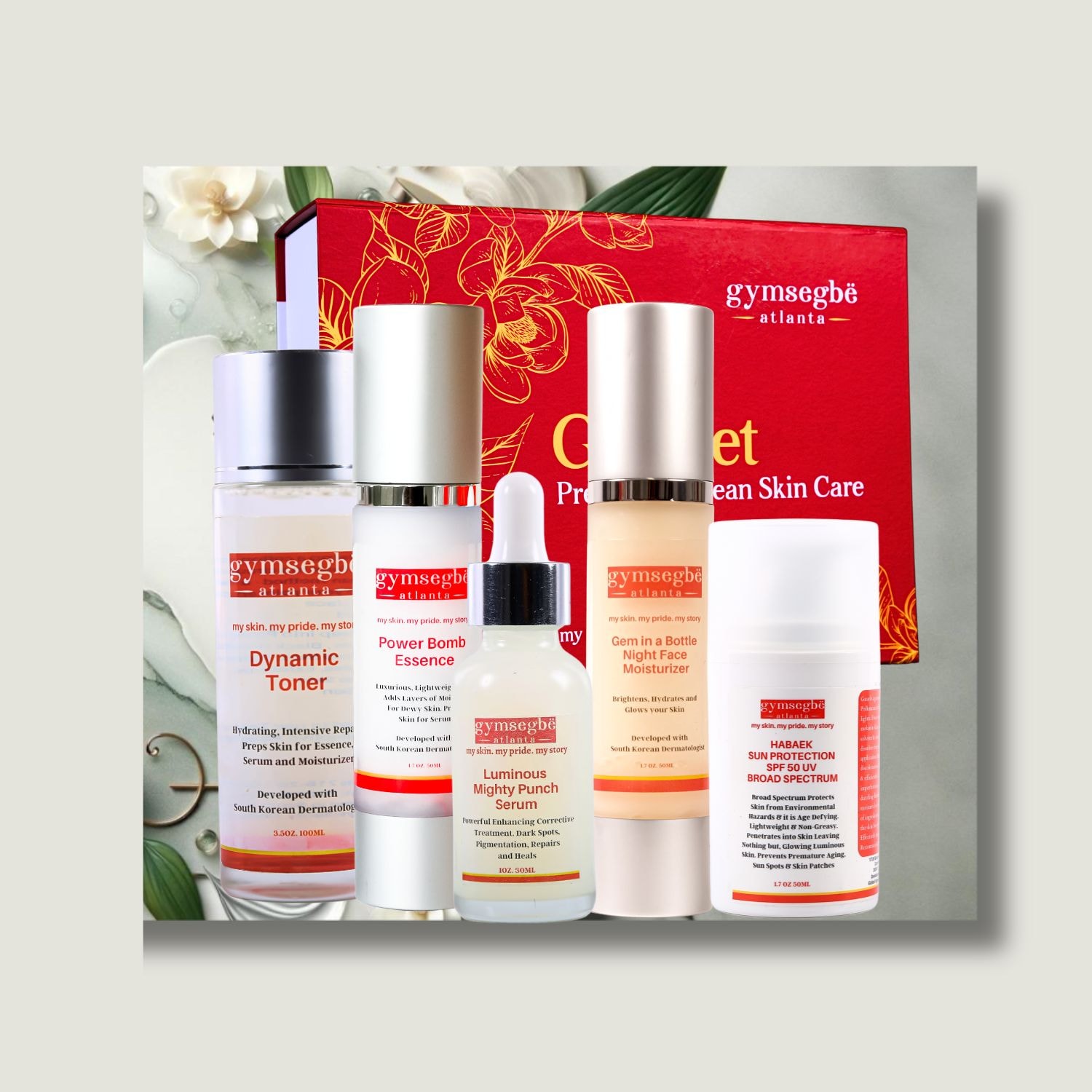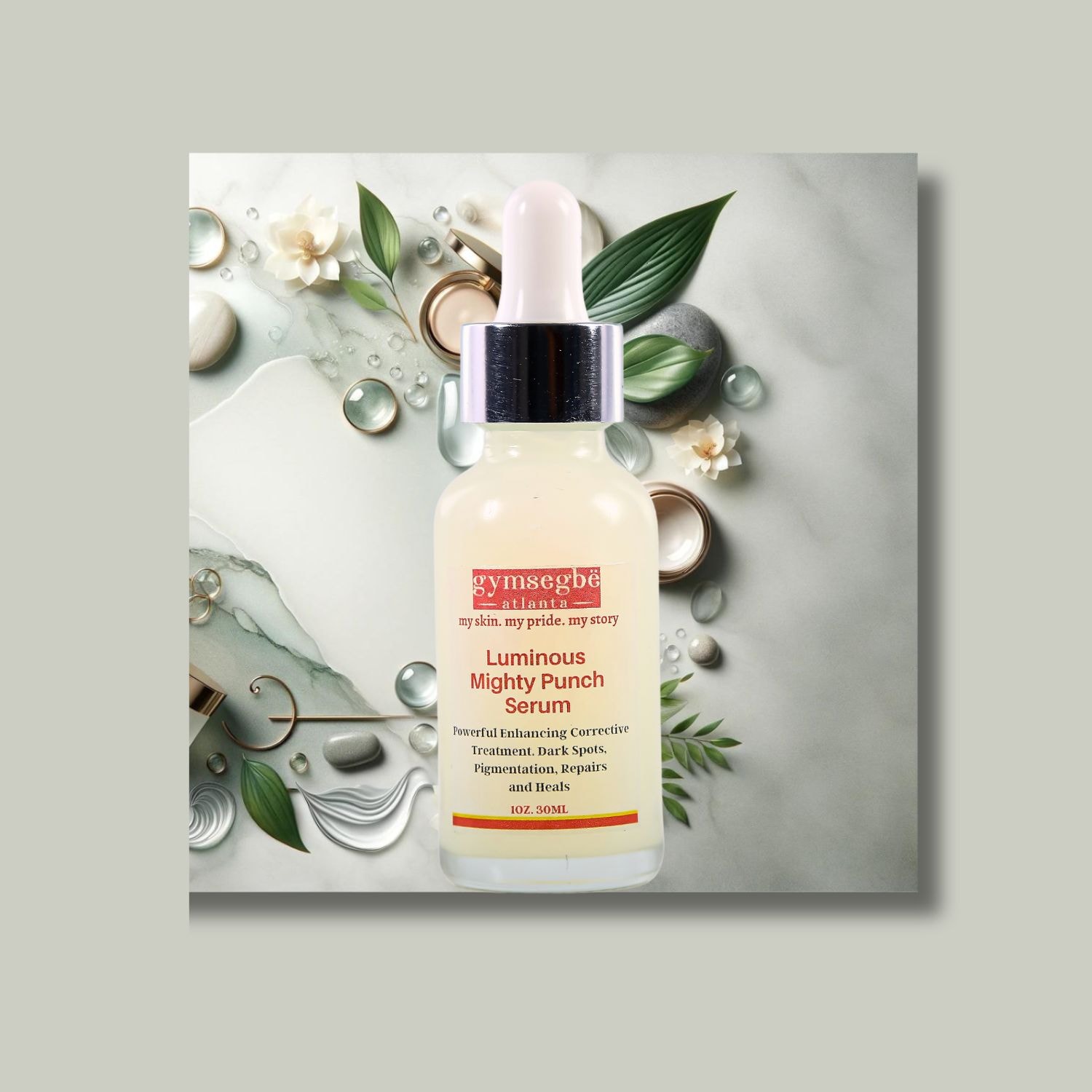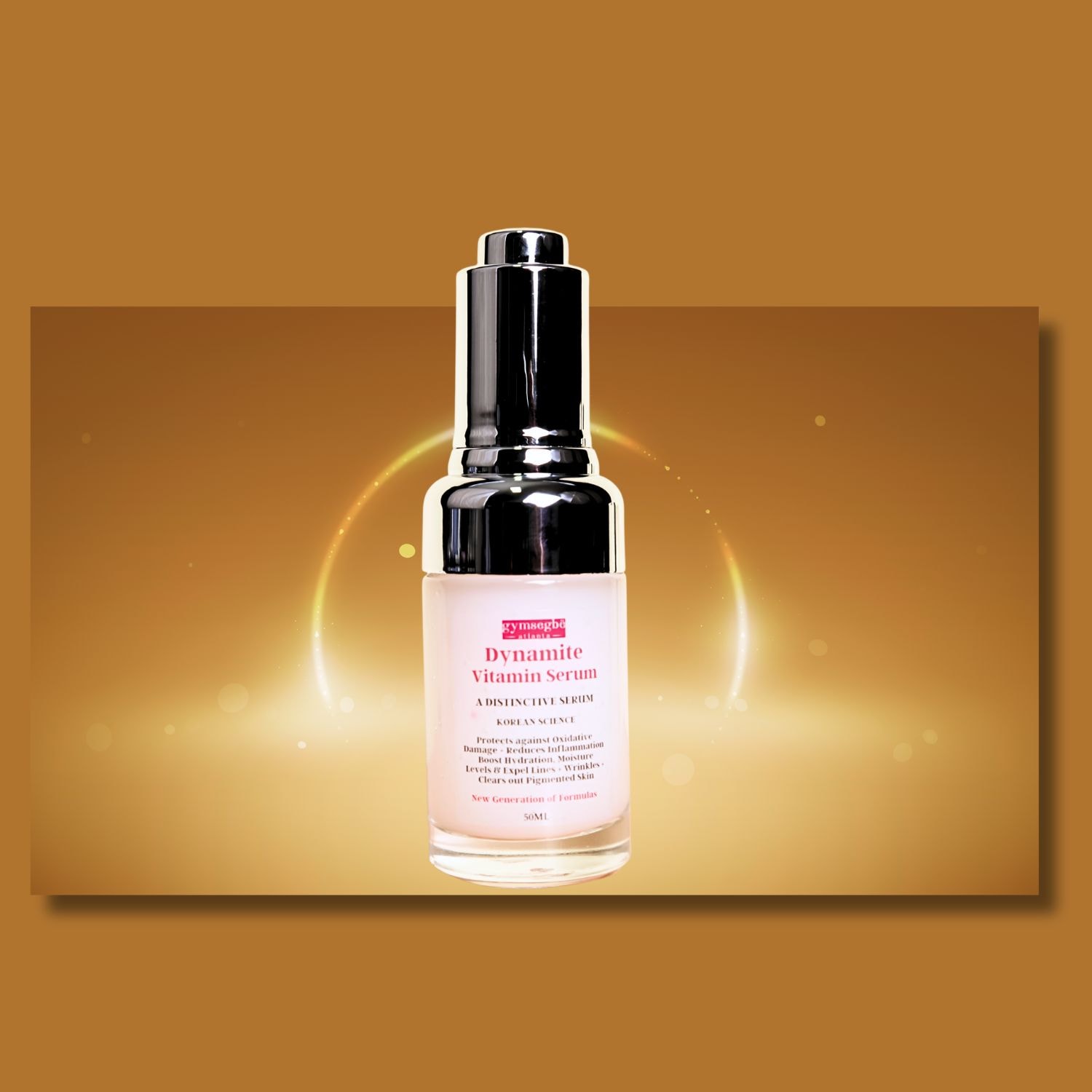How To Layer Korean Skincare Products

Mastering the Art of Layering Korean Skincare Products for Glowing Skin
Korean skincare has taken the beauty world by storm, and for good reason. The Korean skin care routine, with its meticulous multi-step regimen, promises glowing, youthful skin and has left many wondering how to achieve such flawless results. This guide will help skincare enthusiasts, health-conscious women, and beauty bloggers understand how to layer Korean skincare products effectively.
What Sets gymsegbë Apart:
Gymsegbe Korean Skincare brings together the best of Korean beauty traditions with advanced formulations to create effective, natural, and results-driven products
Here's what sets Gymsegbe apart in the world of skincare:
High-Quality, Natural Ingredients
Targeted, Comprehensive Solutions
Gentle Formulations for All Skin Types
Innovative Korean Skincare Practices
Luxurious, Effective Results
gymsegbë is committed to offering premium Korean skincare solutions that reflect the essence of K-beauty—clean, natural, and highly effective
Introduction to the Korean Skincare Routine
The Korean skincare routine is renowned for its comprehensive and methodical approach to skincare. Using a cleansing oil as the first step in the routine effectively removes dirt, oil-based impurities, makeup, pollution, and sunscreen by binding them with oil for thorough cleansing. Originating from South Korea, this multi-step routine focuses on hydration, protection, and achieving a natural, dewy glow. Unlike many Western routines, which may prioritize quick fixes and heavy-duty treatments, the Korean approach is about nurturing the skin over time with gentle, yet effective products.
Understanding the Concept of Layering
Layering skincare products is a fundamental aspect of the Korean skincare routine. The technique involves applying multiple layers of products in a specific order to maximize their benefits. Layering ensures that each product penetrates the skin effectively and works synergistically with others. This method differs from Western practices, where products may be used more sporadically or in isolation.
When layering, it is important to choose products suitable for sensitive skin to avoid irritation and ensure optimal results.

Benefits of Layering
-
Enhanced Absorption: Each layer preps the skin for the next, allowing for better absorption of active ingredients.
-
Targeted Treatment: By layering, you can address multiple skin concerns simultaneously.
-
Hydration: Multiple layers of hydrating products ensure your skin remains plump and moisturized throughout the day.
-
Skin Healthy: Layering helps keep the skin healthy by maintaining balance and hydration.
Breaking Down the Steps
1. Oil-Based Cleanser
The first step in the Korean skincare routine is using an oil cleanser. This helps to remove makeup, sunscreen, and other oil-based impurities. Massage the cleanser onto dry skin and rinse with lukewarm water.
2. Water-Based Cleanser
Follow up with a water-based cleanser to remove any remaining impurities such as sweat and dirt. This double cleansing method ensures your skin starts with a clean slate, ready to absorb the next layers.

3. Exfoliator
Exfoliation is crucial for removing dead skin cells and promoting cell turnover. Use a gentle exfoliator 1-2 times a week to keep your skin smooth and bright.
Physical exfoliators can be particularly suitable for oily or acne-prone skin.

The Importance of Choosing the Right Exfoliator
Selecting the right exfoliator is essential to avoid irritation and achieve optimal results. There are two main types of exfoliators: physical and chemical. Physical exfoliators use granular substances to manually slough off dead skin cells. Common ingredients include sugar, salt, or microbeads. While effective, they can sometimes be abrasive and should be used with caution, especially on sensitive skin.
Chemical exfoliators, on the other hand, use active ingredients like Alpha Hydroxy Acids (AHAs) and Beta Hydroxy Acids (BHAs) to dissolve dead skin cells. AHAs, such as glycolic acid and lactic acid, are water-soluble and best suited for dry or sun-damaged skin. BHAs, such as salicylic acid, are oil-soluble and more effective for oily or acne-prone skin. These chemical exfoliators tend to be gentler but equally effective in promoting cell turnover and improving skin texture.

How to Incorporate Exfoliators into Your Routine
When incorporating an exfoliator into your skincare routine, it's important to strike a balance. Over-exfoliation can lead to irritation, redness, and even breakouts. Start by using an exfoliator once or twice a week and observe how your skin responds. Gradually increase the frequency if your skin tolerates it well.
Apply the exfoliator after your water-based cleanser and before toning. If using a physical exfoliator, gently massage it onto the skin in circular motions, avoiding the delicate eye area, and rinse thoroughly. For chemical exfoliators, follow the product's instructions, which might suggest leaving it on for a few minutes before rinsing or simply applying it with a cotton pad. Always follow up with soothing and hydrating products to restore the skin's barrier.
By choosing the appropriate exfoliator and integrating it wisely into your routine, you can enjoy the benefits of smoother, brighter skin without the risk of over-exfoliation.
4. Toner
Toners in Korean skincare are designed to hydrate and prep the skin for better absorption of subsequent products. Choose a hydrating toner and apply it with a cotton pad or your hands.

5. Essence
Essence is a lightweight, hydrating liquid that enhances the effectiveness of other products. Pat it gently into your skin to boost hydration and improve skin texture.

The Role and Benefits of Essence
Essence plays a pivotal role within the Korean skincare routine, often touted as the centerpiece of the entire regimen. The formulation is designed to be lightweight and thus allows for deeper penetration into the skin. One of the primary benefits of using an essence is its ability to boost skin cell renewal, which aids in maintaining a youthful complexion. Packed with active ingredients like hyaluronic acid, glycerin, and various botanical extracts, essences offer intense hydration and help in improving the overall texture and clarity of the skin.
Moreover, essences prepare the skin to better absorb subsequent products, enhancing the efficacy of serums, ampoules, and moisturizers applied afterward. Regular use can lead to visibly plumper and more radiant skin, as it maintains an optimal moisture balance and fortifies the skin’s barrier. In addition to hydration, essences can also contain specific ingredients to address various skin concerns, such as brightening formulations to combat hyperpigmentation or soothing components for sensitive skin. By integrating an essence into your skincare routine, you create a solid foundation for the rest of your skincare products to build upon.
6. Serums and Ampoules
This step allows for targeted treatment of specific skin concerns such as wrinkles, pigmentation, or acne. Use serums and ampoules with active ingredients suited to your needs.
For those with oily skin, choose serums and ampoules specifically formulated to manage excess oil and prevent breakouts.
7. Eye Cream
The delicate skin around your eyes requires special care, and eye creams are essential for hydrating, plumping, and brightening this area. Apply an eye cream to help reduce puffiness, dark circles, and fine lines.

8. Moisturizer
Lock in all the previous layers with a moisturizer. Choose one that suits your skin type, whether it’s a lightweight gel or a rich cream.

9. Sunscreen
The final step is arguably the most important. Sunscreen protects your skin from harmful UV rays, preventing premature aging and skin cancer. Apply it every morning, regardless of the weather.

The Importance of Sunscreen
Sunscreen is a non-negotiable component of any skincare regimen, safeguarding your skin against the damaging effects of ultraviolet (UV) rays. There are two main types of UV rays that can harm your skin—UVA and UVB. UVA rays can prematurely age your skin, causing wrinkles and age spots, while UVB rays can burn your skin. Both types of rays can lead to skin cancer, making daily sunscreen application crucial for long-term skin health.
When choosing a sunscreen, look for broad-spectrum protection, which shields your skin from both UVA and UVB rays. It's also essential to select a sunscreen with an appropriate Sun Protection Factor (SPF). Dermatologists generally recommend using an SPF of 30 or higher for effective protection.
Additionally, consider your skin type and any specific skin concerns you may have. For example, those with oily or acne-prone skin might prefer a lightweight, non-comedogenic formula that won’t clog pores, while individuals with dry skin might benefit from a hydrating sunscreen with moisturizing ingredients.
To maximize its effectiveness, sunscreen should be applied generously 15 minutes before sun exposure and reapplied every two hours, or more frequently if swimming or sweating. Incorporating this step into your morning routine ensures you’re protected throughout the day, helping you maintain a healthier, more youthful complexion.
Tips for Effective Layering
Apply Products from Thinnest to Thickest
Start with the lightest, most water-like products and move towards heavier, oil-based products. This ensures each layer is absorbed properly.
Allow Each Layer to Absorb
Give your skin time to absorb each product before applying the next. This typically takes about 30 seconds to a minute.
Customize Your Routine
Not every step is necessary for everyone. Tailor the routine to your skin’s needs, eliminating steps that may be too much for your skin type.
Personalized Routine Building
Identify Your Skin Type
Understanding whether your skin is dry, oily, combination, or sensitive is crucial in choosing the right products.
Address Specific Concerns
If you have acne, look for products with salicylic acid or tea tree oil. For anti-aging, incorporate products with retinol or peptides.
It's also important to choose products suitable for sensitive skin, such as gentler, chemical exfoliators.
Seasonal Adjustments
Your skin’s needs can change with the seasons. Use richer creams in winter and lighter gels in summer.
Common Mistakes to Avoid
Over-Exfoliating
Exfoliating too often can damage your skin barrier. Stick to 1-2 times a week.
Using Incompatible Ingredients
Some active ingredients don’t work well together and can irritate your skin. For example, avoid using retinol and vitamin C simultaneously.
Skipping Sunscreen
Never skip sunscreen, even if you’re indoors or it’s cloudy outside.
Case Studies and Reviews
Real-Life Example 1
Name: Jessica
Skin Type: Combination
Routine: Jessica followed the 10-step Korean skincare routine for 3 months. She noticed a significant improvement in her skin’s texture and hydration levels. Her before-and-after photos show a brighter, more even complexion.
Real-Life Example 2
Name: Sarah
Skin Type: Dry
Routine: Sarah customized the routine to focus on hydration. She used hydrating toners, essences, and moisturizing creams. Her skin became plumper and her dry patches disappeared.
Thought-Provoking Conclusion
The Korean skincare routine offers a comprehensive and effective way to achieve glowing, healthy skin. By understanding and mastering the art of layering skincare products, you can address multiple skin concerns and enhance your overall complexion. We encourage you to try this method and share your experiences. For personalized advice, consider booking a consultation with a skincare expert.
Remember, your skin is unique, so take the time to understand what works best for you. The journey to flawless skin is a marathon, not a sprint, but with dedication and the right products, you’ll see amazing results.





















